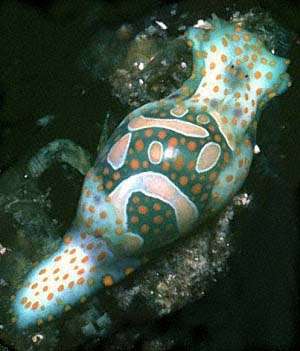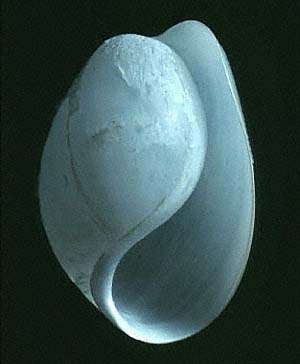Re: Haminoea cymbalum & H. simillima
March 21, 1999
From: C. Carlson & P.J. Hoff


Bill,
Here is a partial response to the three animals in the 'cymbalum' discussion. I will send this in three parts. We believe that Lindsay's 78 & 79 are separate species and have included some material from specimens found on Guam. Haminoea cymbalum has been fairly consistent in its color pattern when we have found it. It is easily separable from the other orange spotted specimens in our collection by the nature of it's gizzard
plates as well as color. The gizzard plates of H. cymbalum are relatively smooth with a hint of a series of ridges but lacking the high profile ridges as well as the heavy concentrations of chitinous rods found in both '78' & '79'.
There is a problem with the identification 'cymbalum'. It is difficult to tell from Quoy & Gaimard's original drawing which one of the many rotund shells was being shown. The specimen in the Paris Museum that represents Q & G's 'cymbalum' is much larger than what Q & G described. It has been suggested that the shell of H. navicula (da Costa, 1778) was substituted. The earliest name we feel represents 'cymbalum' is H. simillima Pease, 1868.
A possible host for H. simillima is the red algae, Laurencia, in which it is often found.
UPPER PHOTO: Guam, Bile Bay, reef flat; 12.5mm long; 25 Oct. 1976. LOWER PHOTO: Shell, 8.5 x 5.0mm
Clay & Patty Jo
Clay Carlson & Patty Jo Hoff
Merizo, Guam.
clay.carlson@kuentos.guam.net
Carlson, C. & Hoff, P.J., 1999 (Mar 21) Re: Haminoea cymbalum & H. simillima. [Message in] Sea Slug Forum. Australian Museum, Sydney. Available from http://www.seaslugforum.net/find/709Dear Clay & Patty Jo,
Thanks for your contribution. I hoped you would see my request for help. It's many years since I looked inside a Haminoea, but I remember finding the penis morphology to be a good species character. I have seen specimens of what I call H. cymbalum from Australia, Fiji, India and East Africa. I will need to have a look at my drawings etc to sort out what I had.
I have continued using 'cymbalum' at this moment, not because I disagree with you on simillima, but through a prudent inertia. I'll see if anyone else joins the debate before changing filenames, indices etc.
Best wishes,
Bill Rudman.
Related messages
-
Mass spawning in Haminoea cymbalum
From: Philibert Bidgrain, February 16, 2007 -
Haminoea cymbalum from the Cook Islands
From: Marcus Coltro, May 26, 2006 -
Trailing in Haminoea cymbalum from Reunion Island
From: Philibert Bidgrain, October 18, 2005 -
Haminoea cymbalum from Christmas Island
From: W.B. Rudman, May 8, 2002 -
Haminoea? from the Philippines
From: Erwin Koehler, June 14, 2001 -
Sesquiterpene molecule from Haminoea cymbalum
From: Brett Baker, April 15, 2001 -
Haminoea cymbalum in southern Queensland
From: John Bodman, June 29, 2000 -
Re: Haminoea cymbalum in aquaria
From: Nathan Cope, August 19, 1999 -
Keeping Haminoea cymbalum in aquaria
From: Nathan Cope, August 17, 1999 -
Food of Haminoea cymbalum
From: Clay Carlson, March 24, 1999 -
Haminoea cymbalum? from Sulawesi
From: Lindsay Warren, March 18, 1999
